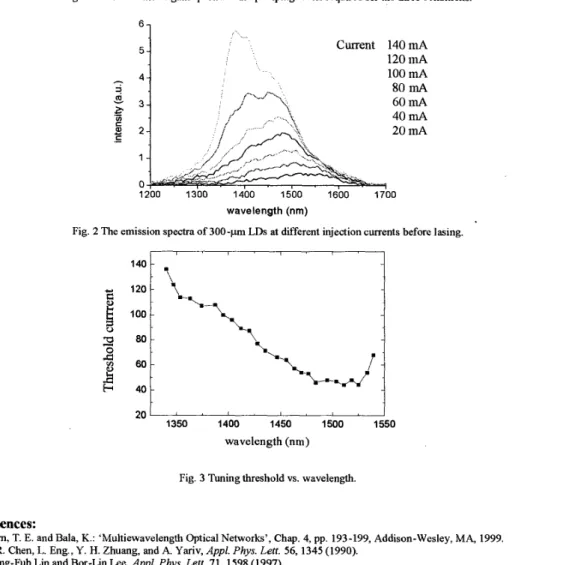CTuM2
6
Broadly Tunable External-Cavity Semiconductor
Lasers in Optical-Communication Band Using Fabry-
Perot Laser Diodes without Anti-Reflection Coating
Yi-Shin Su, Fei-Hung Chu, and Ching-Fuh
L h
Graduate Institute ofElectro-Optical Engineering Graduate Institute of Electronics Engineering
And
Department ofElectrica1 Engineering National Taiwan University
Taipei 106, Taiwan ROC
Tel: 886-2-23635251 ext. 339IFax: 886-2-2363824 7
Email: cflin~cc.ee.iitu.sdu.tw
Abstract: Using proper quantum-well structure, carriers distribute over a broad bandwidth, suppressing self-oscillation of uncoated Fabry-Perot laser diodes, but still providing gain for external-cavity configuration. Then broadband tuning range of 200nm is achieved.
02002 Optical Society of America
OCIS Codes: (140.3600) Lasers, tunable; (250.5980) Semiconductor optical amplifiers 1. Introduction
The mass transfer of data stimulates the broadband requirements in optical communication. Many efforts are thus devoted to expanding bandwidth. With optical fibers covering nearly from 1200nm to 1600nm with the loss less than OSdEVkm, [I] components and systems for optical-fiber communication are therefore demanded to have similar broadband characteristics. However, the bandwidth of Er-doped fiber amp1ifiersAaset-s is much less than the available bandwidth of optical fibers. Semiconductor lasers/amplifiers using multiple-quantum-well (MQW) engineering [2], [3], [4] thus provide alternative choices. Recently, 240 nm tuning range in the external-cavity semiconductor laser using nonidentical MQWs had been reported. [5] However, the threshold current is very high. This work reports broadband tuning of 200 nm with much less threshold current, achieved using uncoated Fabry-Perot (FP) laser diodes (LDs). As the gain bandwidth is broad, camers distribute over a broad spectrum. Then under a certain pumping level, the FP-LDs do not oscillate due to the large mirror loss of the cleaved facets, while the devices still have the gain. As external feedback is provided at a certain wavelengtlk this device can oscillate. Theoretical analysis and experiments show that the broadband characteristics make the uncoated LDs suitable for broadband tuning.
2. Broadband tuning using uncoated LDs
With some algebraic derivations, we obtain three operation situations of uncoated FP-LDs: (i) lasing situation; (ii) round-trip amplification; (iii) single-pass amplification. Fig. 1 schematically shows the gain spectrum and pumping levels required for the above three cases. When the pumping level is between I2 and
4,
the device provides sufficient gain for round-trip amplification, but insufficient gain for lasing without additional feedback. Therefore. when the uncoated FP-LD is set up in an external cavity, tuning can be achieved for the pumping level approximately between I2 and 13. The tuning range is approximately between ?L1 and X 2Nonidentical MQWs were used for the broadband purpose. The broadband characteristics mean that more carriers are required to fill in the energy states spreading over the broad spectrum. Thus the threshold current for the uncoated LDs is larger than the LDs with conventional MQWs. The increased threshold then gives a large range of pumping level between I2 and I3 for operation in this work. Also, the gain spectrum is significantly broadened when the pumping level increases from I2 to Ij.
FP-LDs with 3-pm-wide ridge-waveguide were fabricated. The threshold current is around 140 mA. Fig. 2 shows the broad spectra of the LDs before lasing. The LD is set up in an external cavity consisting of
CTuM2
6
a grating for wavelength tuning. Fig. 3 shows the threshold current vs. the tuning wavelength. For the injection cumnt below 140 mA, the wavelength is tunable
from
1340nm
to 1540 nm without the concern of self-oscillation in the FP-LD. The output power could be morethan
15m W
for a large tuning range. Details will be reported in the presentation.t
Pumping level for lasing condition, IsC .e
8
hl \\ b wavelength A2Fig. 1 The schematic of gain spectrum and pumping levels required for the three conditions 6 5 Current 140 mA 120 mA 4 100 mA 80 mA 60 mA Y m 3 40 mA $ 2 20 mA
-
? c c 1 0 1200 1300 1400 1500 1600 1700 wavelength (nm)Fig. 2 The emission spectra of 300-pm LDs at different injection currents before lasing.
140
1
1201
100 40 20.
+
=-\--I
1
1350 1400 1450 1500 1550 wavelength (nm)Fig. 3 Tuning threshold vs. wavelength.
References:
[l] Stem, T. E. and Bala, K.: ‘Multiewavelength Optical Networks’, Chap. 4, pp. 193-199, Addison-Wesley, MA, 1999. [2] T. R. Chen, L. Eng., Y. H. Zhuang, and A. Yariv, Appl. Phys. Left. 56,1345 (1990).
[3] Ching-Fuh Lin and Bor-Lin Lee, Appl. Phys. Left. 71, 1598 (1997).
[4] X. Zhu, D. T. Cassidy, M. J. Hamp, D. A. Thompson, B. J. Robinson, Q. C. Zhao, and M. Davies, IEEE Photon. Technol. Letf.9,
[ 5 ] Ching-Fuh Lin, Yi-Shin Su, and Bing-Ruey Wu, CLEO ’01, Tech. Dig., 2001, pp.237-238. 1202 (1997).
